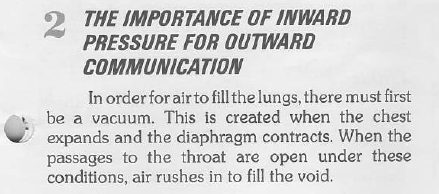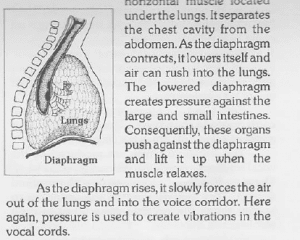The copy I have of this wisdom booklet is a bit cut off at the top of one page so this section is missing a line or two. Yet again, problems occur:
- There is no vacuum within the lungs themselves during breathing. The critical vacuum occurs between the lungs and the wall of the chest.
- That vacuum keeps the lungs attached to the wall of the chest so that the volume of the lungs expands and contracts as the chest moves.
- If that vacuum fails because of a hole in a lung or a hole in the wall of the chest, one or both lungs can detach from the chest wall or collapse. When a lung collapses, it does not work at all. This is a medical emergency. A collapsed lung can be fixed by placing a tube in the chest known as a pneumothorax tube until the injury heals.
- Collapsed lungs are common in premature infants who have immature lungs. I had two pneumothorax tubes placed in my first week of life. I had no long-term consequences from the procedure except for two small scars on my chest.
- I’ve never heard the term “voice corridor” used before. I’d substitute “trachea and larynx” since this portion is about vocal sound production.
- The rest is reasonably correct. There’s a neat demonstration people can do at home to show how the lungs work using half a plastic pop bottle, two balloons, a straw, some clay or a cork, and rubber bands. Here’s a website with written instructions and a YouTube video for the visual learners. I came up with a series of adaptations to demonstrate when I taught anatomy (and because I like messing around with models….)
- You can demonstrate a collapsed lung by poking a hole in the bottle with a sharp needle or a nail.
- Let your kids try to figure out how to fix a collapsed lung.
- The trick is to fix the hole while having the chest wall under a lot of pressure so the air between the chest wall and the lungs is forced out. Doing that will create a near-vacuum.
- In real life, you would have the person exhale as hard as they can and quickly patch the hole/wound with something that is air-tight like a sheet of plastic.
- For the model, you squish the bottle hard while pushing up on the “diaphragm” and plug the hole with a wad of clay, saran-wrap or play-dough.
- You can also demonstrate choking and the Heimlich maneuver using the lung model. You can obstruct the trachea using a piece of clay. The Heimlich maneuver is essentially pushing the diaphragm upward quickly and forcefully.
- If the obstruction is small enough, the Heimlich maneuver will knock it free.
- If it is too large, you can demonstrate emergency intubation by shoving a small coffee stirrer down the trachea to bypass the obstruction.
- You can also demonstrate why the Heimlich maneuver won’t work if the person can still talk, cough or make sounds. If you put a small bit of clay on one side of the trachea to model a partial obstruction, you’ll see that the Heimlich maneuver does nothing but potentially injure the other person.
















